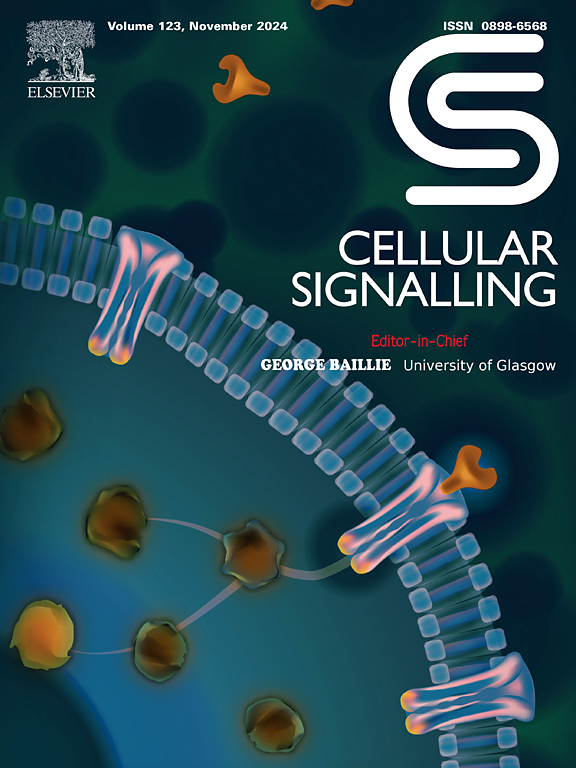AECII-derived miR-21a-5p exosomes alleviate HALI via targeting and regulating PGAM5-mediated necroptosis
IF 4.4
2区 生物学
Q2 CELL BIOLOGY
引用次数: 0
Abstract
Hyperoxic Acute Lung Injury (HALI) is a serious complication of prolonged high-concentration oxygen therapy, primarily leading to Acute Respiratory Distress Syndrome (ARDS), which primarily affects alveolar epithelial cells (AECs). Exosomes (Exos) derived from type II alveolar epithelial cells (AEC IIs) play a crucial role in lung protection through their contained microRNAs (miRNAs). Previous research has established miR-21a-5p as a key player in pulmonary defense mechanisms. In this study, we utilized a C57BL/6 mouse model of HALI established by hyperoxic conditions (FiO2 > 90 %) to demonstrate a gradual decrease in miR-21a-5p levels concomitant with an increase in PGAM5 levels with prolonged hyperoxia exposure. Exosomal transcriptome sequencing suggested significant downregulation of miR-21a-5p expression in hyperoxia-stimulated AECII exosomes. We employed dual-luciferase reporter assays and Chromatin Isolation by RNA Purification (ChIRP) to confirm the direct interaction between miR-21a-5p and PGAM5. AECII-derived exosomal miR-21a-5p effectively attenuated lung injury and inhibited the expression of proteins associated with PGAM5-mediated necroptosis (RIPK1, RIPK3, p-MLKL). Furthermore, in vitro assays using MLE-12 cells confirmed that AECII-derived exosomal miR-21a-5p intervention reversed the elevated levels of necroptotic apoptotic proteins in hyperoxia-stimulated MLE-12 cells. These findings collectively demonstrate that AECII-derived exosomal miR-21a-5p inhibits necroptosis pathway activity by modulating PGAM5, thereby exerting lung-protective effects. Therefore, exosomal miR-21a-5p may serve as a novel therapeutic target for attenuating HALI via modulation of the PGAM5-mediated necroptotic pathway.
源于 AECII 的 miR-21a-5p 外泌体通过靶向和调节 PGAM5 介导的坏死缓解 HALI
高氧急性肺损伤(HALI)是长时间高浓度氧治疗的严重并发症,主要导致急性呼吸窘迫综合征(ARDS),主要影响肺泡上皮细胞(AECs)。来自II型肺泡上皮细胞(AEC II)的外泌体(Exos)通过其所含的microRNAs (miRNAs)在肺保护中发挥关键作用。先前的研究已经确定miR-21a-5p在肺防御机制中起关键作用。在本研究中,我们使用高氧条件(FiO2 >;90%)证明miR-21a-5p水平随着长时间高氧暴露而逐渐降低,同时PGAM5水平升高。外泌体转录组测序显示,高氧刺激的AECII外泌体中miR-21a-5p表达显著下调。我们采用双荧光素酶报告基因检测和染色质分离RNA纯化(ChIRP)来证实miR-21a-5p和PGAM5之间的直接相互作用。aecii衍生的外泌体miR-21a-5p有效地减轻了肺损伤,抑制了与pgam5介导的坏死性坏死相关的蛋白(RIPK1, RIPK3, p-MLKL)的表达。此外,使用MLE-12细胞进行的体外实验证实,aecii衍生的外泌体miR-21a-5p干预逆转了高氧刺激的MLE-12细胞中坏死凋亡蛋白的升高水平。这些发现共同证明,aecii来源的外泌体miR-21a-5p通过调节PGAM5抑制坏死性坏死通路活性,从而发挥肺保护作用。因此,外泌体miR-21a-5p可能作为一种新的治疗靶点,通过调节pgam5介导的坏死性凋亡途径来减轻HALI。
本文章由计算机程序翻译,如有差异,请以英文原文为准。
求助全文
约1分钟内获得全文
求助全文
来源期刊

Cellular signalling
生物-细胞生物学
CiteScore
8.40
自引率
0.00%
发文量
250
审稿时长
27 days
期刊介绍:
Cellular Signalling publishes original research describing fundamental and clinical findings on the mechanisms, actions and structural components of cellular signalling systems in vitro and in vivo.
Cellular Signalling aims at full length research papers defining signalling systems ranging from microorganisms to cells, tissues and higher organisms.
 求助内容:
求助内容: 应助结果提醒方式:
应助结果提醒方式:


